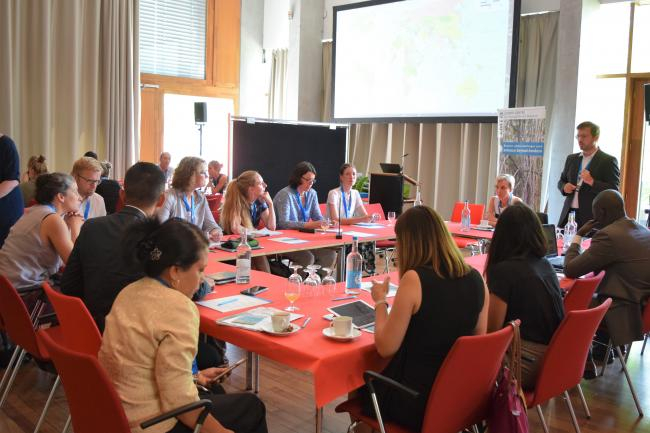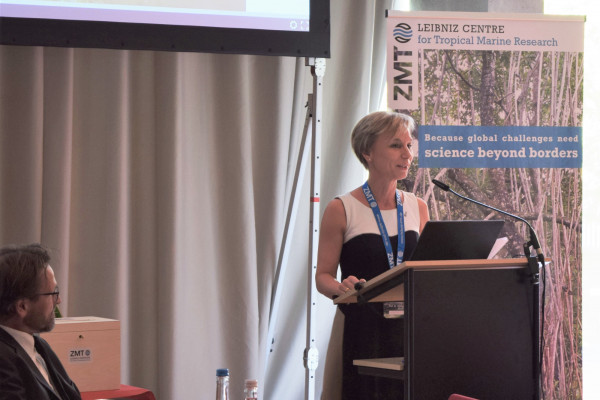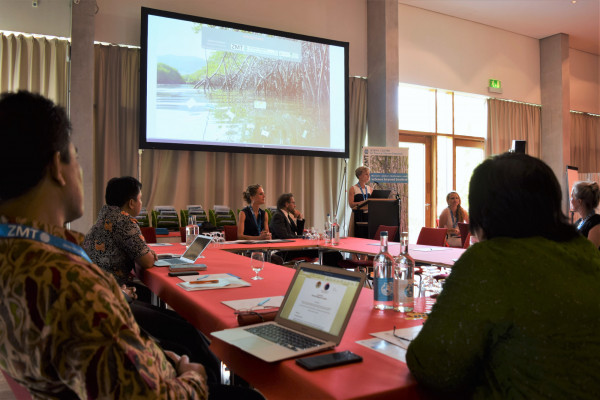04/07/2019 | Last week, the Leibniz Centre for Tropical Marine Research (ZMT) hosted the "1st Future Mangrove Day" at the “Vertretung des Landes Bremen beim Bund” in Berlin. A total of 35 representatives from the fields of science, business, society and politics attended the event. With global expertise in the field of mangrove research, capacity development and consulting, ZMT set itself the goal of entering into an intensive dialogue with the participants on the future and options for mangrove protection. Professor Martin Zimmer, head of the working group Mangrove Ecology at ZMT, first gave an impulse talks scientifically examining existing and future challenges for these coastal ecosystems. Afterwards, the participants took part in three workshops to discuss mangroves and climate change, the threat of pollution and the importance of mangroves for food security in tropical regions. The different workshops aimed at identifying problems and developing potential solutions together.
Summaries of the workshops:
"Mangroves and Pollution": – Prof. Dr. Nils Moosdorf, head of working group Submarine Groundwater Discharge (ZMT)
During a warm-up exercise, the participants positioned themselves along two directions in the room thus weighting if they perceive mangroves as important or unimportant in their context and if they perceive mangroves as polluted or pristine in their context. As most of the participants positioned themselves in the area that indicated important and polluted, the discussion on different pollution types and pathways could start. Both groups highlighted different aspects of mangrove pollution. While examples from the first group focused mostly on plastic pollution and chemical pollution, e.g. from e-waste or the military, the second group highlighted oil waste and fertilizer/pesticides specifically. Most of the pollution in mangroves can be from an internal source, while it can be assumed that most of the communities living in mangroves actually have an interest in their good environmental status, or from external sources. Pathways from external sources can be e.g. rivers, groundwater, or ocean currents. While in the examples, often highly visible pollution was mentioned (e.g. plastic), often the invisible pollutants (e.g. pesticides) are more harmful to the environment and their impact on mangroves is still only little known. There are plenty of ways to reduce pollution, but they need to be tailored for individual locations and be developed with the local communities. Examples were given of girls collecting plastic cups to get a small pocket-money or a local community that built a waste-catching device in their river to prevent plastic from upstream to pollute their area. The lively discussions highlighted the diverseness of the topic but also showed some possible pathways to improve the pollution situation in mangroves.
"Mangroves and Food Security" – Paula Senff, doctoral candidate in the working group Ecophysiology (ZMT)
The second workshop introduced a sustainable method of food production: integrated mangrove aquaculture (IMA). The workshop leader Paula Senff briefly explained what IMA is: “Integrated mangrove aquaculture is a more sustainable mode of practicing aquaculture in mangrove areas that maintains or restores tree cover in and around the ponds, with the aim to maintain a level of ecosystem function that also improves aquaculture production.” Despite the clear advantages for food quality and long-term nature protection, IMA has not been integrated in many mangrove regions, yet. The goal of this workshop was to create awareness for the difficulties that IMA integration in mangrove regions faces, using a “stakeholder roundtable discussion” format. Participants of the workshop were asked to take different views from selected stakeholder groups, including shrimp pond farmers, artisanal fishers, wood collectors, government extension workers, and conservationists. In subsequent round table discussions, various challenges were discussed: new, more sustainable types of food production would definitely increase food quality, but if it comes along with a decrease of quantity, it would require an increase of food prices to enable the livelihood of farmer families. Can this be affordable for local families? This challenge would require a well-balanced effort with support from government. On the positive side, sustainability efforts could also enable complete novel types of jobs (e.g. mangrove foresters), although the workshop participants acknowledged that only few local people would benefit from this while stakeholders who depend on open access to mangroves, such as fishers and wood collectors, could see their livelihood threatened. Moreover, due to a lack of experience, integration of IMA would require intense trainings of the local people as well as infrastructure funding support, and could probably only be achieved by convincing local people rather than forcing them to integrate IMA. This would be easier in regions where farmers already face problems in their food production and loss in harvest and recognize a link to the degraded ecosystem. Supporting the farmers to get access to sustainable supply chains would additionally facilitate IMA integration.
Summarized, the workshop participants agreed that IMA is a huge chance for the future of mangroves, but also acknowledged that challenges coming along with IMA need to be actively solved together with the local farmers.
"Mangroves und Climate" – Prof. Dr. Martin Zimmer, head of working group Mangrove Ecology (ZMT)
The two groups differed in their perception of the topic, with the first round-table session mostly considering climate change the biggest threat for mangrove ecosystems, while sea-level rise and exploitation were seen as biggest threats by the second roundtable session. Both groups essentially agreed on the two perspectives of mangroves being threatened by climate change versus serving in mitigating and supporting adaptation to climate change by coastal protection. While mangroves store large amounts of CO2 per unit area, they globally cover only a very small area, compared to, e.g., tropical rain forests. Mangroves harbor many animals and plants, but their biodiversity is rather low, compared to, e.g., tropical rain forests. From this perspective, neither climate change mitigation nor biodiversity per se seem to be major reasons for protecting mangroves, although these are the ones mostly proposed in the public. Rather, livelihood and wellbeing of local communities and adaptation to climate-change related threats (such as food security and coastal protection) should be in the focus. Neither of the round table sessions came to an unambiguous conclusion as to how to argue best and honestly to get the awareness for the need of mangrove protection. In the final plenary discussion, the group followed the initiative of Dr. Veronique Helfer (ZMT) to start working on a joint position paper about honest argumentation in science-public communication, with a special focus on the perception of which are the biggest threats for mangrove ecosystems.





















































